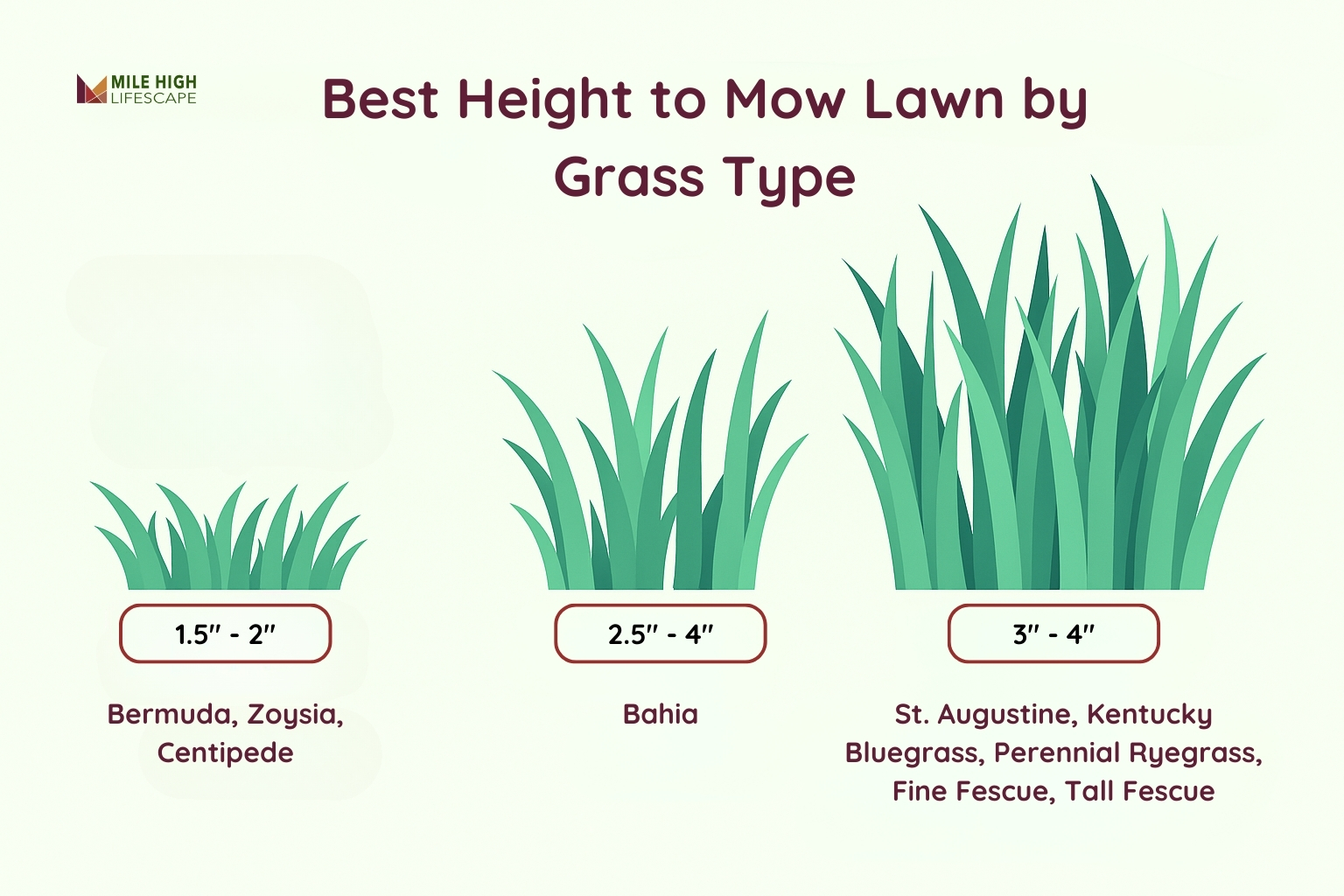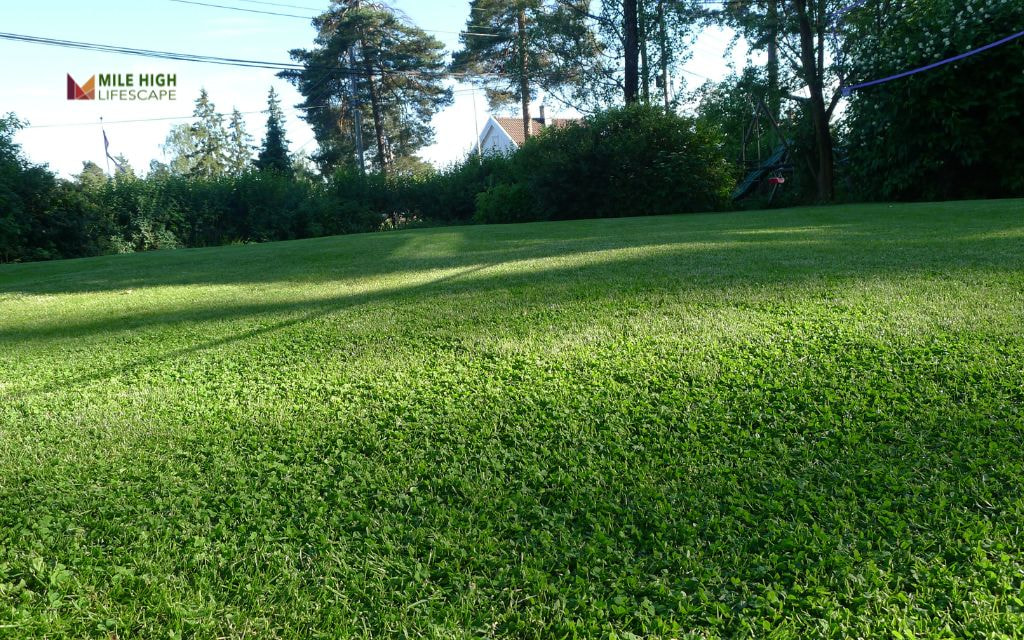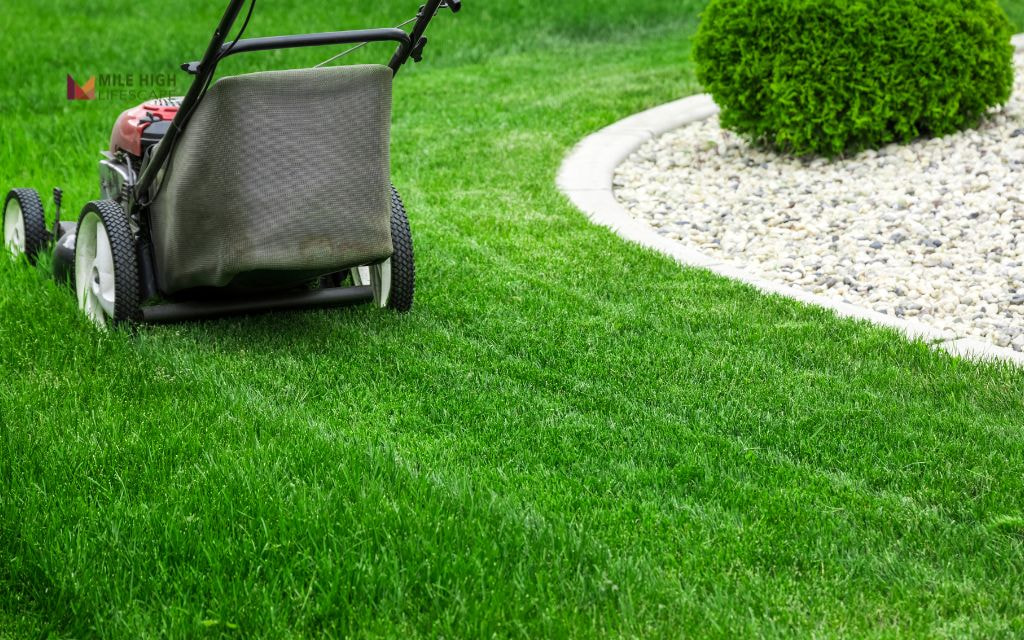For most lawns, the best mowing height is around 2.5 to 3.5 inches. This height helps the grass absorb sunlight, provides shade for the soil, and helps it compete against weeds. Keep in mind that the ideal mowing height may differ a bit based on the grass type and the season.
However, many homeowners cut their grass too short, thinking a golf-course appearance signifies proper maintenance. This common mistake damages your lawn, particularly in Denver’s challenging climate. Our high altitude exposes grass to intense UV radiation, while our semi-arid conditions demand water-efficient practices for lawn survival.
At Mile High Lifescape, we’ve witnessed the transformation proper mowing height brings to Denver lawns. The following guidance draws from our regional lawn care experience, helping you optimize mowing height based on grass type, season, and local conditions.
What’s the Best Height to Mow Lawn by Grass Type?
Denver lawns typically feature cool-season grasses that thrive in our climate when maintained at proper heights. Understanding your specific grass type enables precise maintenance decisions.
| Grass Type | Ideal Mowing Height | Notes |
| Kentucky Bluegrass | 2.5″ – 3.5″ | Increase height during summer heat |
| Fine Fescue | 2.5″ – 4″ | Performs well in shade; requires less frequent mowing |
| Perennial Ryegrass | 2″ – 3″ | Cut more frequently due to faster growth rate |
| Hybrid Bluegrass | 2.5″ – 3″ | Drought-resistant variety common in newer Denver lawns |
- Kentucky bluegrass dominates Denver landscapes due to its cold tolerance and recovery ability. This grass develops deep root systems when maintained at 3 inches, improving drought resistance during our hot summers.
- Fine fescue varieties offer excellent shade performance and require less water, making them valuable in mixed-grass lawns. Their slower growth pattern allows for maintaining taller heights without frequent mowing.
For lawns containing multiple grass types, adjust your mower to accommodate the dominant variety or use the higher end of the range. This approach protects all grass types while promoting uniform appearance.
Denver lawns thrive with proper care, and mowing height is key. We’ve seen how the right height boosts lawn health, but what about new grass? If you’ve recently overseeded, knowing when to cut after overseeding is crucial for success. You can find detailed guidance on to ensure your new seedlings establish properly.

Adjusting Mowing Height by Season
Denver’s distinct seasons require strategic mowing height adjustments to support lawn health throughout the year.
Our region experiences sudden temperature fluctuations and afternoon thunderstorms during summer. Maintaining taller grass provides resilience against these unpredictable weather patterns while reducing irrigation requirements.
Spring (April-May)
Begin the season cutting at the lower end of your grass type’s range (approximately 2.5 inches) to remove winter debris and stimulate new growth.
As temperatures rise, gradually increase cutting height to prepare for summer heat. This transition prevents stress during seasonal changes and encourages root development.
Summer (June-August)
Raise your mower to the maximum recommended height (3-3.5 inches for most Denver lawns). Taller grass shades soil, reducing evaporation and protecting roots from intense mountain sunlight.
Denver temperatures routinely exceed 90°F in summer, and taller grass blades provide critical protection against heat stress and water loss.

Fall (September-October)
Maintain moderate height (around 3 inches) as growth slows. This height supports continued photosynthesis while reducing disease risk during cooler, more humid conditions.
The final mowing before winter dormancy should gradually reduce height to about 2.5 inches to prevent snow mold development.
Winter (November-March)
Cease mowing once grass becomes dormant. Avoid walking on frosted lawns to prevent damage to frozen grass blades.
The Science Behind Mowing Height and Lawn Health
Understanding the biological relationship between grass height and health explains why proper mowing practices deliver superior results.
Root Development and Depth
Taller grass blades support more extensive root development. The root system typically extends to a depth proportional to above-ground growth. When you maintain grass at 3 inches instead of 1.5 inches, you potentially double the root depth. These deeper roots access soil moisture unavailable to shallow-rooted lawns – a critical advantage during Denver’s dry periods.
Photosynthesis
Proper mowing height maximizes photosynthesis capacity. Grass produces energy through photosynthesis in the leaf blades. More surface area equals increased energy production, strengthening the entire plant. This energy surplus supports recovery from stress, disease resistance, and overall turf density.
Natural Weed Prevention
Taller grass naturally suppresses weeds through shade competition. Weed seeds require sunlight to germinate. When your lawn maintains proper height, less sunlight reaches the soil surface, reducing weed establishment opportunities. This natural weed control reduces the need for chemical treatments.
The Critical One-Third Rule
Cutting too short (scalping) forces grass to divert stored energy to emergency blade production rather than maintaining robust roots. This stress cycle weakens the entire plant, opening opportunities for disease and weed invasion.
The “one-third rule” preserves plant health by preventing shock. Never remove more than one-third of the grass blade height in a single mowing. This approach maintains sufficient leaf surface for continued photosynthesis while encouraging lateral growth for denser turf.

Common Mistakes: Why Cutting Too Short Backfires
Despite good intentions, many Denver homeowners damage their lawns through improper mowing height. Understanding these common errors helps prevent costly recovery processes.
- Scalping causes immediate stress and long-term damage: Removing too much leaf tissue forces the plant to redirect resources from root maintenance to emergency blade growth. This creates a cycle of weakening that compounds with each mowing.
- Short mowing heights increase water requirements significantly: Exposed soil experiences higher evaporation rates, while reduced root depth limits water uptake capacity. This combination creates drought stress even during moderate dry periods.
- Low-cut lawns become weed magnets: Reduced turf density and increased soil light exposure create perfect conditions for weed germination. The resulting weed competition further weakens grass plants.
- Frequent low mowing depletes plant energy reserves: Grass stores carbohydrates for stress periods. Constant removal of leaf tissue prevents this energy storage, leaving your lawn vulnerable to disease and environmental challenges.
Denver’s high altitude intensifies these issues. Our thinner atmosphere allows more ultraviolet radiation to reach your lawn, increasing stress on exposed grass crowns when cut too short. Maintaining proper height provides natural protection against this regional challenge.
Mowing Tips for Healthier, Low-Stress Lawns
Implementing professional mowing practices transforms lawn health while reducing maintenance requirements:
- Follow the one-third rule consistently: This principle preserves sufficient leaf surface for energy production while encouraging lateral growth. During rapid growth periods, this may require more frequent mowing to avoid removing excess height.
- Mow when grass is dry: Wet blades clump and cut unevenly, creating entry points for disease. Additionally, wet soil compacts under mower weight, restricting root growth and water penetration.
- Maintain sharp blades throughout the season: Dull blades tear grass rather than cutting cleanly, increasing water loss and disease vulnerability. Professional services sharpen blades weekly during peak growing seasons.
- Alternate mowing patterns to prevent soil compaction and encourage upright growth. This simple adjustment prevents wear patterns while promoting even turf density.
- Leave clippings on the lawn when using properly maintained equipment. These clippings return valuable nutrients to the soil, reducing fertilizer requirements by up to 25%. Modern mulching mowers distribute clippings effectively without causing thatch buildup.
- Avoid mowing during extreme heat, particularly between 10 AM and 4 PM during summer months. Grass experiences additional stress during high temperatures, and cutting during these periods compounds the impact.
Denver Specific: Our region’s rapid drying conditions make evening mowing ideal. This timing allows grass to recover overnight before facing the next day’s heat and sun exposure.

How to Adjust Your Mower for the Right Cut
Achieving precise cutting height requires proper equipment setup. Follow these steps to optimize your mower performance.
- Consult your mower manual for height adjustment mechanisms specific to your model. Most walk-behind mowers feature lever adjustments at each wheel, while riding mowers typically use a single control lever.
- Place your mower on a flat, hard surface like a driveway or sidewalk. Measure the distance from the ground to the bottom edge of the mower blade. This measurement determines actual cutting height.
- Adjust settings to your target height based on grass type and season. Test the setting on a small section before mowing the entire lawn, making further adjustments if needed.
- Maintain blade sharpness by having blades professionally sharpened every 4-6 weeks during the growing season. Dull blades damage grass regardless of height settings.
- For uneven lawns, set height toward the higher end of the recommended range to prevent scalping in low spots.
The 5 minutes spent properly adjusting your mower prevents weeks of lawn recovery time. Most modern mowers make height adjustment straightforward, requiring only basic tools or simple lever adjustments.
Conclusion
The best height to mow lawn isn’t merely a technical specification – it’s a fundamental practice that transforms lawn health. Maintaining proper mowing height delivers deeper roots, natural weed suppression, and improved drought tolerance without additional cost or effort.
Denver’s unique climate presents challenges that proper mowing height helps overcome. By adjusting your approach seasonally and understanding your specific grass type, you create conditions for lawn success while reducing water and chemical requirements.
Proper mowing is essential for a healthy lawn, but it’s not the only factor. Knowing when to start mowing a new lawn is equally important. For guidance on when to mow new grass, refer to our comprehensive article. Understanding both initial and ongoing mowing practices ensures a thriving Denver lawn.
Whether you implement these practices yourself or partner with Mile High Lifescape’s lawn care experts, proper mowing height forms the foundation of sustainable lawn care. The result is a resilient, attractive landscape that withstands Colorado’s challenging conditions while requiring fewer inputs.
Frequently Asked Questions (FAQs)
What’s the best height to cut grass in Colorado?
Colorado’s diverse elevations and microclimates influence optimal cutting heights. Along the Front Range, including Denver, maintaining cool-season grasses between 2.5-3.5 inches provides the best balance of appearance and drought resilience.
What is the best mowing height for Kentucky bluegrass?
Kentucky bluegrass thrives between 2.5-3.5 inches, with heights toward the upper end recommended during summer heat. This height promotes deep root development while protecting against Denver’s intense UV exposure.
What’s the best mowing height for Tall Fescue in Denver?
Tall fescue performs best when maintained between 3-4 inches in Denver’s climate. This height maximizes its drought tolerance while supporting its naturally deep root system – valuable traits during water restrictions.
Should I mow lower in the spring?
Yes, but moderately. Begin spring mowing at the lower end of your grass type’s recommended range to remove winter debris and stimulate growth. For most Denver lawns, this means approximately 2.5 inches rather than summer’s 3-3.5 inches.
How often should I mow to maintain ideal height?
Follow the one-third rule rather than a strict schedule. During peak growing seasons (late spring and early summer), this typically translates to mowing every 5-7 days. Frequency decreases during summer heat and fall slowdown.
Does mowing height affect weed control?
Absolutely. Taller grass creates shade that prevents weed seed germination by blocking sunlight from reaching the soil. This natural suppression reduces the need for chemical controls while promoting denser turf growth.
